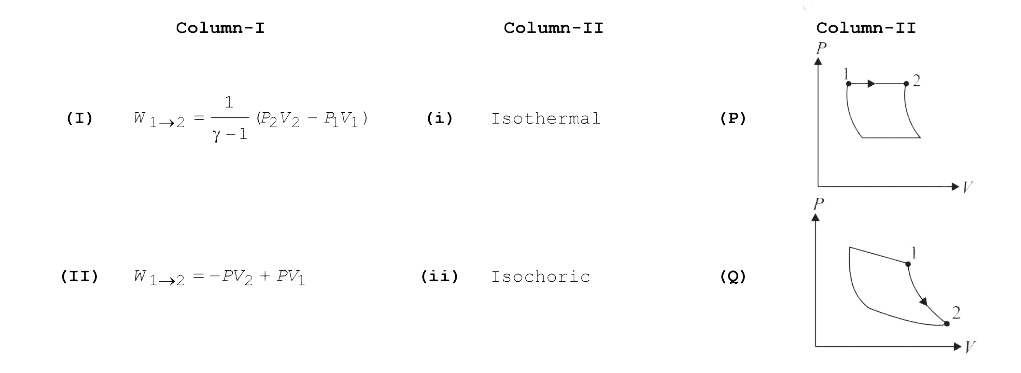Compare the formula Cp−Cv=R for an ideal gas with the thermodynamics relation ΔU=ΔQ−PΔV.
To compare the formula Cp−Cv=R for an ideal gas with the thermodynamic relation ΔU=ΔQ−PΔV, we can follow these steps:
Step 1: Understand the Definitions
- Cp is the specific heat at constant pressure.
- Cv is the specific heat at constant volume.
- R is the universal gas constant.
- ΔU is the change in internal energy.
- ΔQ is the heat added to the system.
- PΔV is the work done by the system during expansion or compression.
Step 2: Consider an Isobaric Process
For an isobaric process (constant pressure), the heat added to the system can be expressed as:
ΔQ=nCpΔT
where n is the number of moles and ΔT is the change in temperature.
Step 3: Express Change in Internal Energy
The change in internal energy for an ideal gas can be expressed as:
ΔU=nCvΔT
Step 4: Work Done by the System
The work done by the system during an isobaric process can be expressed as:
W=PΔV
Using the ideal gas law PV=nRT, we can express PΔV as:
PΔV=nRΔT
Step 5: Apply the First Law of Thermodynamics
According to the first law of thermodynamics:
ΔU=ΔQ−W
Substituting the expressions we have:
nCvΔT=nCpΔT−nRΔT
Step 6: Rearranging the Equation
Rearranging the equation gives:
nCvΔT+nRΔT=nCpΔT
Dividing through by nΔT (assuming ΔT≠0):
Cv+R=Cp
This can be rearranged to give:
Cp−Cv=R
Conclusion
Thus, we have derived the relation Cp−Cv=R using the first law of thermodynamics and the definitions of specific heats for an ideal gas.
---
- Cp is the specific heat at constant pressure.
- Cv is the specific heat at constant volume.
- R is the universal gas constant.
- ΔU is the change in internal energy.
- ΔQ is the heat added to the system.
- PΔV is the work done by the system during expansion or compression.
For an isobaric process (constant pressure), the heat added to the system can be expressed as:
ΔQ=nCpΔT
where n is the number of moles and ΔT is the change in temperature.
The change in internal energy for an ideal gas can be expressed as:
ΔU=nCvΔT
The work done by the system during an isobaric process can be expressed as:
W=PΔV
Using the ideal gas law PV=nRT, we can express PΔV as:
PΔV=nRΔT
According to the first law of thermodynamics:
ΔU=ΔQ−W
Substituting the expressions we have:
nCvΔT=nCpΔT−nRΔT
Rearranging the equation gives:
nCvΔT+nRΔT=nCpΔT
Dividing through by nΔT (assuming ΔT≠0):
Cv+R=Cp
This can be rearranged to give:
Cp−Cv=R
Thus, we have derived the relation Cp−Cv=R using the first law of thermodynamics and the definitions of specific heats for an ideal gas.
Topper's Solved these Questions
- GASEOUS STATE & THERMODYNAMICSBook:VMC MODULES ENGLISHChapter:GASEOUS STATE & THERMODYNAMICSExercise:level-0 Short Answer Type – II
Explore 24 Videos
- GASEOUS STATE & THERMODYNAMICSBook:VMC MODULES ENGLISHChapter:GASEOUS STATE & THERMODYNAMICSExercise:Level - 1
Explore 75 Videos
- GASEOUS STATE & THERMODYNAMICSBook:VMC MODULES ENGLISHChapter:GASEOUS STATE & THERMODYNAMICSExercise:JEE ADVANCED (ARCHIVE )
Explore 111 Videos
- ENERGY & MOMENTUMBook:VMC MODULES ENGLISHChapter:ENERGY & MOMENTUMExercise:JEE ADVANCE (ARCHIVE) - TRUE/FALSE TYPE
Explore 1 Video
- GRAVITATIONBook:VMC MODULES ENGLISHChapter:GRAVITATIONExercise:JEE Advance (Archive) TRUE/FALSE
Explore 1 Video
Similar Questions
CP−CV for an ideal gas is………….. .
View SolutionAn ideal gas is undergoing a cyclic thermodynamic process in different ways as shown in the corresponding P-V diagrams in column 3 of the table. Consider only the path from state 1 to state 2. W denotes the corresponding work done on the system. The equations and plots in the table have standard notations as used in thermodynamic process. Here is the ratio of heat capacities at constant pressure and constant volume. The number of moles in the gas in n.


Which of the following options is the only correct representation of a process in which ΔU=ΔQ−PΔV?
View Solution
Knowledge Check
For hydrogen gas Cp−Cv=a and for oxygen gas Cp−Cv=b. So, the relation between a and b is given by
Aa=16 bB16a=bCa=4bDa=b
Correct relation for isothermal reversible expansion of an ideal gas is ΔU=0, ΔS=0,ΔG=−TΔS, ΔH=0
View SolutionFind CpCv for monatomic ideal gas.
View SolutionFind CpCv for monatomic ideal gas.
View SolutionAn ideal gas is taken from state A to state B via three different processes as shown in the pressure volume(P−V) diagram. If Q1, Q2 &Q3 indicates the heat absorbed by the gas and ΔU1 , ΔU2 &ΔU3 indicate change in internal energy in three processes, then
_PHY_E05_030_Q01.png)
View SolutionThe energy density uV of an ideal gas is related to its pressure P as
View SolutionHeat of reaction is defined as the amount of heat absorbed or evolved at a given temperaturewhen the reactants have combined to form the products is represented by a balanced chemcial equation. If the heat is denofed by q then the numerical value of q depends on the manner in which the reaction is performed for the two methods of conducting chemical reactions in calorimeters.
Constant volume W = 0 and qv=ΔE Bomb calorimeter
Constant pressure W = - V ΔP, therefore qP=ΔE+PΔVrar(V.ΔP)
The heat capacity of a bomb calorimeter is 300 JK When 0.16 gm of methane was burnt in this calorimeter the temperature rose by 3∘C. The value of ΔU per mole will be
a. 100 KJ
b. 90 KJ
c. 900 KJ
d. 48KJ
View SolutionHeat of reaction is defined as the amount of heat absorbed or evolved at a given temperaturewhen the reactants have combined to form the products is represented by a balanced chemcial equation. If the heat is denofed by q then the numerical value of q depends on the manner in which the reaction is performed for the two methods of conducting chemical reactions in calorimeters.
Constant volume W = 0 and qv=ΔE Bomb calorimeter
Constant pressure W = - V ΔP, therefore qP=ΔE+PΔVrar(V.ΔP)
The heat of combustion of maltose at constant volume in the above question if water vapour are not condensed
View Solution

